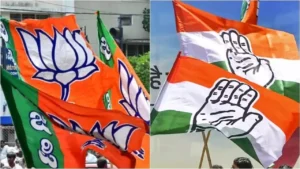India, with multi diversity, has caste to play a crucial role in day-to-day life. Similarly, caste politics is a founding path of Rajasthan’s assembly elections.
Jats, Rajputs, Meenas, and Gujjars are the four castes that define the whole scenario of Rajasthan’s polls. Assembly elections of 23 November in Rajasthan will be strongly influenced by which caste goes with which political party candidate.
Caste composition in Rajasthan
Rajasthan has 200 Assembly seats, where four castes, Jats, Rajputs, Meenas, and Gujjars, play a prominent role in electing candidates and forming government in the state.
Before the upcoming assembly elections, the state saw a series of Mahapanchayats in the capital city of Jaipur, where prominent caste leaders gave a message to both the Congress and the BJP to carefully analyze the caste factors before distributing tickets to the candidates.

The Jat community forms the biggest caste group in Rajasthan, with 9% of the total population. They have influence mainly in the Marwar and Shekhawati regions of Rajasthan, and they have a strong hold on 85 constituencies.
The community sent 42 MLAs across party lines to the state Assembly in the last election. Their influence can be felt in Rajasthan as both BJP and Congress opted for Satish Poonia and Govind Dotasara, both from the Jat community, as their unit chiefs.
But BJP has shifted to C.P Joshi, a Brahmin face and MP from Chittorgarh, as Rajasthan BJP’s chief in March 2023. It can hurt the Jat voters in elections.
Another dominant group in Rajasthan, Rajputs, has trusted the BJP for a long time. Whether it’s the inclusion of royal families in the BJP or the two Chief Ministers, Vasundra Raje, and Bhairaon Singh Shekhawat, the BJP has always been successful in getting a good proportion of votes from this community. Rajputs account for about 6% of the total population in the state.
In the 2018 elections, the BJP gave tickets to 29 Rajput candidates out of whom 24 won the elections, while the Congress gave tickets to 15 candidates out of whom only two could win. This equation might seem to repeat itself in this election of 2023.

With the good strategy of including Rajyavardhan Rathore and Diya Kumari in this assembly elections and their already strong state leadership, the BJP has managed to get a strong hold on this caste equation with the Rajput community.
In the last elections of 2018, Gujjar, who have traditionally voted for the BJP candidates in Rajasthan, shifted their votes towards Congress as they were sure about Sachin Pilot’s candidacy to become Chief Minister once Congress came to power. However, they were left highly disappointed when he was made Deputy Chief Minister and later removed. This move by Congress has hurt the sentiments of the Gujjar people. It, in return, could go in favor of the BJP.
BJP, by carefully looking at all scenarios has successfully roped in several young leaders from the Gujjar community and given them tickets to content this 2023 assembly elections. This can work strongly for the BJP to woo Gujjar voters and vote for their party.
Gujjar community has an influence on around 30 seats, mainly in the Karauli, Tonk, Hindaun, and Dausa districts of eastern Rajasthan.
When it comes to the Meena caste in Rajasthan, about 65 percent of Meena people are likely to vote for the BJP in the state. The Congress is to get nearly 18 percent of Meena votes. Around 17 percent of Meena voters in Rajasthan may side with other parties.
Political experts in the state believe that the BJP is better at managing the caste equation than Congress.
Between the BJP, Congress, and four major castes power game, it is important not to forget the Dalit voters in Rajasthan. Azad Samaj Party (AZP) is also present in the election picture.

Rashtriya Loktantrik Party (RLP) tie up with Azad Samaj Party (AZP) brought Jats with the Dalit community. They together can harm a much larger vote base of the BJP and Congress voters. Hanuman Baniwal of Rashtriya Loktantrik Party (RLP) by praising the tie up with Azad Samaj Party (AZP) said “Kisan, jawan, and Dalit to come together”.
Conclusion
By counting on BJP’s strategic moves in the assembly elections of 2023, the party made Jagdeep Dhankhar, a Jat face, Vice President, while a Brahmin C.P. Joshi has been made Rajasthan BJP chief and Rajendra Rathore, a Rajput, as the leader of the Opposition in the Rajasthan Assembly.
This caste arrangement of the BJP looks more colorful and approaching to the voters of Rajasthan than the Congress. This will surely yield good results for the saffron party.
However, Congress also tried to woo these castes voters by constituting boards in the names of Veer Tejaji and Maharana Pratap.

It would be interesting to see how the tie up between Rashtriya Loktantrik Party (RLP) and Azad Samaj Party (AZP) would shape the voting in the Rajasthan Assembly Elections 2023. Will they be able to shift Jats and Dalit’s votes towards them?
Unlike caste in Rajasthan, tribes like Zo and Bru refugees in Mizoram play role in assembly election of 2023. India’s multi-diversity in caste and tribes define the political setup of the nation.
The final ball is in the court of castes to shape the political system of the Rajasthan. 23 November 2025 is the final day on which the people of Rajasthan will vote and select their representatives.












